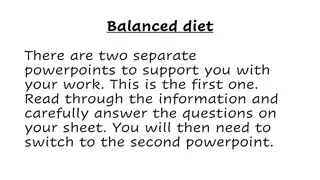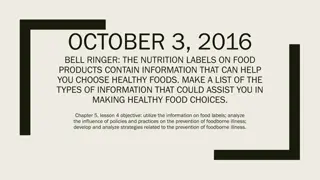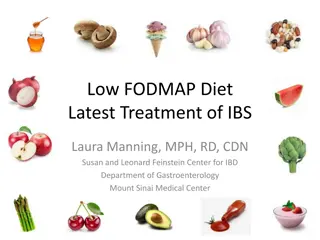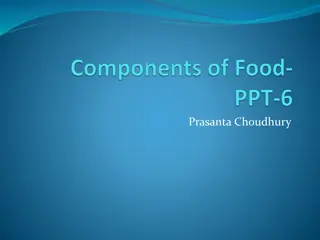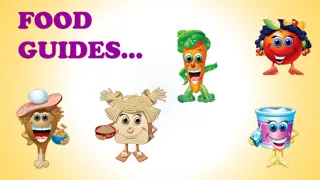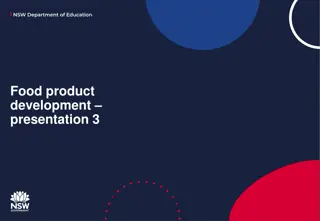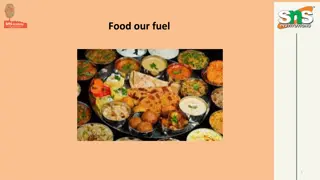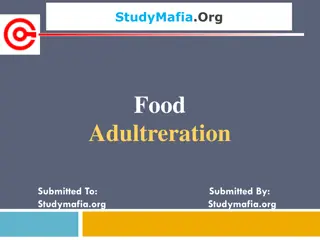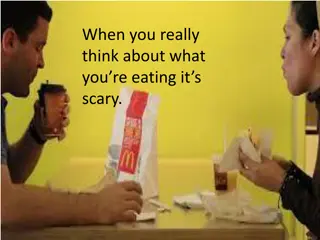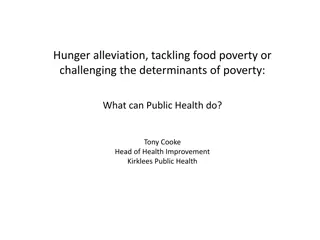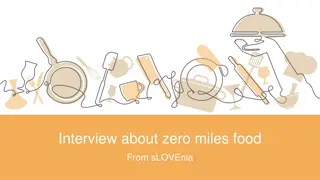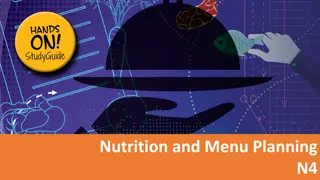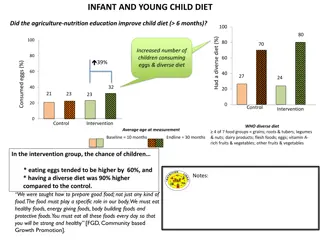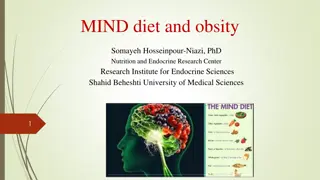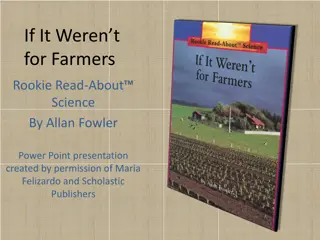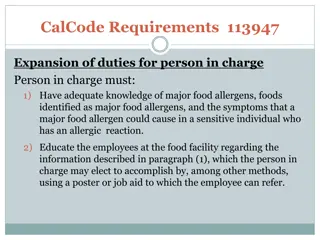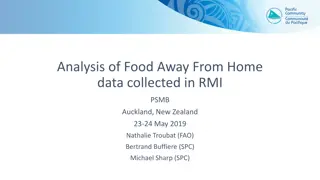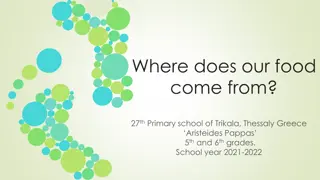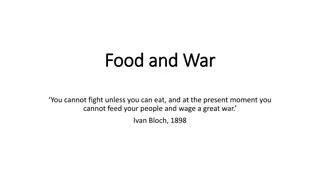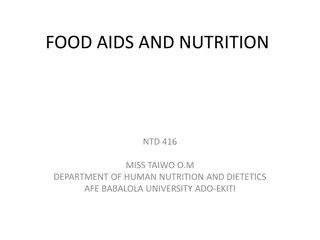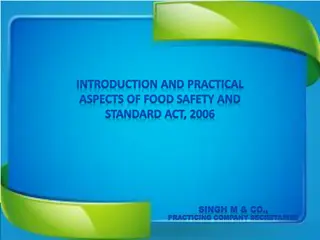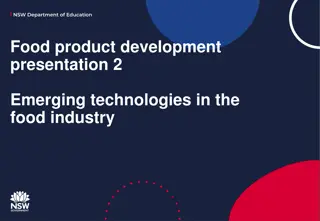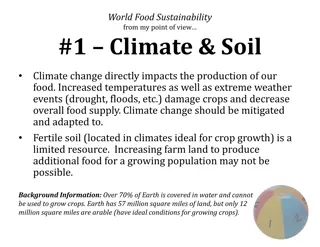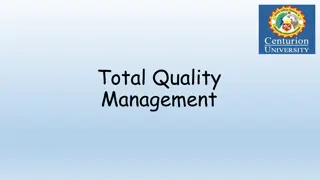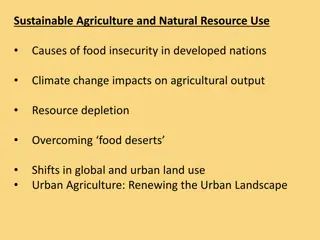Understanding the Importance of Food in our Diet
Food plays a crucial role in providing energy, supporting growth, repairing cells, and sustaining life processes like metabolism and continuity. This article explores why we need food, the essential chemical elements in food, and the biomolecular structures that make up different types of food.
Download Presentation

Please find below an Image/Link to download the presentation.
The content on the website is provided AS IS for your information and personal use only. It may not be sold, licensed, or shared on other websites without obtaining consent from the author. Download presentation by click this link. If you encounter any issues during the download, it is possible that the publisher has removed the file from their server.
E N D
Presentation Transcript
1.3.1 Function of Food Why do we need food?
Need to know The Function of Food Three reasons for requiring food 2
Food is needed for: 1.Energy 2.Growth of new cells and Repair of existing cells, tissues, organs, etc. 3
Food also supplies: the materials and energy for the processes of: 1. Metabolism and 2. Continuity 4
Learning check Why do we need food? Energy Growth of new cells and Repair of existing cells, tissues, organs, etc. What is metabolism? Metabolism is the chemical reactions that occur in the cells of living organisms What is continuity? Continuity of life is the ability of an organism to exist from generation to the next 5
1.3.2 Chemical Elements Elements in Food
Need to know Chemical elements Six common elements in food Five elements in dissolved salts Three trace elements 7
What is Food made up of? Food is made up of: Six chemical elements C, H, O, N, P, S Salts of Na, Mg, Cl, K, Ca Three trace elements Fe, Cu, Zn 8
Chemical Elements and their Symbols Calcium Ca Nitrogen N Carbon C O Oxygen Chlorine Cl P Phosphorus Copper Cu K Potassium Hydrogen H Sodium Na Fe S Iron Sulphur Mg Zn Magnesium Zinc 9
Need to know Define Biomolecular Structures State that simple biomolecular units are composed of a combination of elements in different ratios e.g. carbohydrates Cx(H2O)y 11
Types of Food The elements combine in different ratios to form different food components (biomolecular units) Food is made up of six different components Water Proteins Lipids Carbohydrates Vitamins Minerals 12
Humans are mainly made up of Water! 13
Carbohydrates Carbohydrates contain the elements Carbon Hydrogen Oxygen The general formula for a carbohydrate is Cx(H2O)y There are twice as many hydrogen molecules as oxygen molecules 14
Learning check What are the six different food components? Water Proteins Lipids Carbohydrates Vitamins Minerals 15
A common carbohydrate General formula = Cx(H2O)y When x = y = 6 We fet the formula C6H12O6 What is the name of this monosaccharide carbohydrate? Glucose 16
Another common carbohydrate General formula = Cx(H2O)y When x = 12 and y = 11 We get the formula C12H22O11 What is the name of this disaccharide carbohydrate? Sucrose 17
Learning check Name the three elements that make up carbohydrates Carbon Hydrogen Oxygen What is the general formula for a carbohydrate? Cx(H2O)y 18
1.3.4 Biomolecular Sources and the Components of Food
Need to know State that simple bio molecular units are composed of a combination of elements in different ratios e.g. carbohydrates Cx(H2O)y Name the element components, bio molecular components and sources of: carbohydrates, lipids and proteins. State that carbohydrates are composed of indivisible units and give examples of these e.g. Monosaccharides glucose; Disaccharides maltose; & Polysaccharides starch/cellulose. 20
Need to know What is a vitamin? Name one water soluble vitamin. Name one water in-soluble vitamin (fat- soluble) List the sources of these vitamins 21
Carbohydrates Carbohydrates contain the elements Carbon Hydrogen Oxygen Usually in the ratio of 1C:2H:1O They have twice as many hydrogen molecules as oxygen molecules 22
3 Types of Carbohydrate Monosaccharides Disaccharides Polysaccharides 23
Monosaccharides These are single sugar molecules simple sugars soluble in water sweet to taste smallest carbohydrate unit Photo Credit fruit image by Edvin selimovic from Fotolia.com Examples: Found in: glucose, fructose fruit 24
Learning check What are the elements that make up all carbohydrates? Carbon Hydrogen Oxygen Can you remember the general formula for a carbohydrate? Cx(H2O)y 25
Disaccharides These are two monosaccharide sugar units joined together known as double sugar molecules soluble in water sweet to taste Sucrose_SpaceFilling Examples: Found in: sucrose, lactose, maltose table sugar, milk 26
Polysaccharides These are Many monosaccharide sugar molecules joined together Not soluble in water Do not taste sweet Example: starch, cellulose Found in: bread, pasta, cereals 27
Learning check Name the three types of carbohydrate Monosaccharides Disaccharides Polysaccharides 28
Lipids Lipids are a diverse group of substances which include fats (solid at room temp.) oils (liquid at room temp.) steroids which include cholesterol and some of the sex hormones waxes which cover insect bodies and plant leaves. 29
Structure of Lipids They are made up of the elements carbon hydrogen oxygen But not have the same ratios as carbohydrates. They are made up of two main types of molecules Fatty acids and Glycerol 30
Learning check Give examples and sources of: Examples Glucose Sources Monosaccharides fruit Fructose Sucrose Table sugar Disaccharides Lactose Starch Milk Bread, Pasta, Polysaccharides Cellulose Cereals 31
Types of Lipid Two of the main types of lipids are Triglycerides Phospholipids 32
Triglyceride This is the smallest lipid Fatty Acid 1 Glycerol It is made up of Fatty Acid 2 3 fatty acid molecules 1 glycerol molecule Fatty Acid 3 and 33
Phospholipids If one fatty acid of a lipid molecule is replaced by a phosphate group then a phospholipid is formed Fatty Acid 1 Glycerol Fatty Acid 2 Phosphate 34
Sources of Lipids Fat in and on meat Butter (80% fat) Cooking oils 35
Learning check The two main types of molecules that make up lipids are: Fatty acids and Glycerol The two main types of lipids are: Triglycerides Phospholipids 36
Proteins Proteins contain the elements Carbon Oxygen Hydrogen Nitrogen Some may also contain sulphur, phosphorous or iron Proteins are found in lean meat, fish, pulses, soya and eggs 37
Structure of Proteins Proteins are made up of long chains of amino acids There are 20 common and several rare amino acids found in proteins More amino acids are found in cells and tissues but are not in proteins Amino acids are joined together by peptide bonds This results in the formation of polypeptide chains 38
Learning check Proteins contain the elements Carbon Oxygen Sometimes they contain sulphur, phosphorous or iron Proteins are made up of long chains of amino acids Hydrogen Nitrogen 39
Vitamins Vitamins are essential organic catalysts of metabolism Needed in small amounts, cannot be produced in the body Must be supplied continuously and in sufficient quantities Differ from each other chemically 40
Vitamins We need Vitamins A, B, C, D, E and K in our diets to keep us healthy Vitamins can be water soluble or fat soluble Vitamins B and C are water soluble Vitamins A, D, E and K are fat soluble 41
Sources of Vitamins Vitamin Source A Green leafy vegetables, Eggs, Cheese, Carrots Lean Meat, Cereals, Nuts B C Citrus Fruits, Green vegetables, Turnips D Milk and Milk products, Sunlight E Vegetable oils, fish, nuts K Green leafy vegetables 42
Learning check What is a vitamin? A vitamin is an essential organic catalyst of metabolism What vitamins dissolve in water? B & C What vitamins are fat-soluble? A, D, E and K 43
1.3.5 Energy Transfer Reactions Anabolic & Catabolic Or Anabolism & Catabolism
Need to know Definition of the terms: Anabolic Catabolic Give an example of each 45
Anabolic Reactions This is where energy is used to make large molecules (e.g. C6H12O6) from smaller ones (e.g. CO2 and H2O) using enzymes e.g. Photosynthesis glucose molecules are formed from carbon dioxide and water using enzymes and the energy from the sun. This is anabolism. Energy is absorbed. 46
An Anabolic Reaction Energy being used to join two small molecules to make a larger molecule Small molecule Small molecule ENERGY Larger molecule 47
Catabolic Reactions This is where energy is released when large molecules (e.g. C6H12O6) are broken down to form smaller ones (e.g. CO2 and H2O) using enzymes e.g. Respiration glucose molecules are broken down by enzymes to form carbon dioxide and water and energy is released. This is catabolism. Energy is released. 48
Learning check Explain Anabolism Energy absorbed. Small large molecules Give an example of an anabolic reaction Photosynthesis Explain Catabolism Energy released. Large small molecules Give an example of a catabolic reaction Respiration 49
CRAP Catabolic Respiration Anabolic Photosynthesis 50


